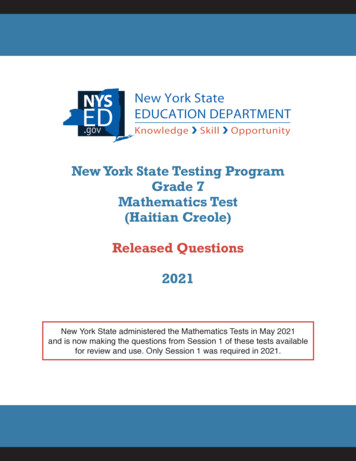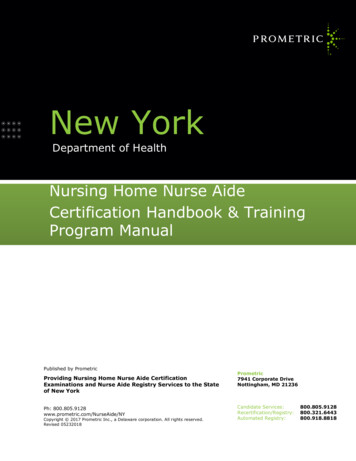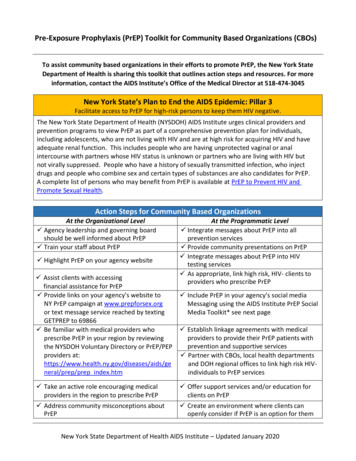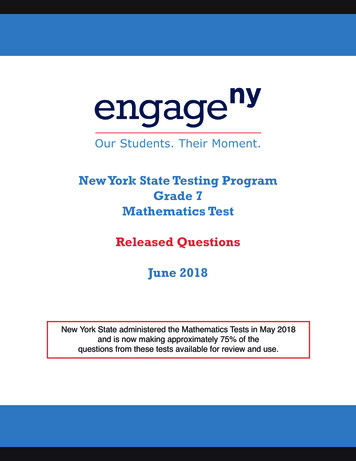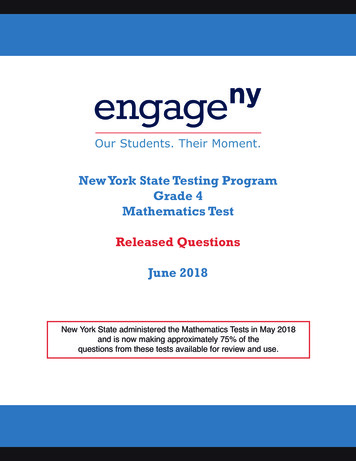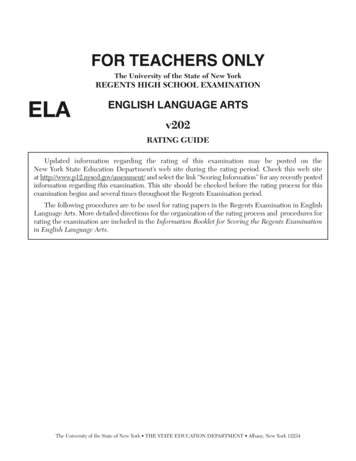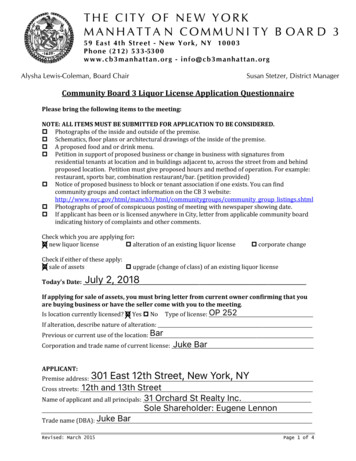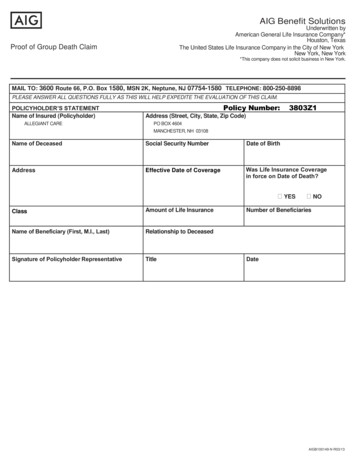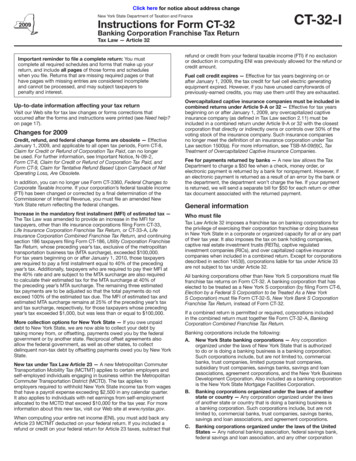
Transcription
Click here for notice about address changeNew York State Department of Taxation and FinanceInstructions for Form CT-32CT-32-IBanking Corporation Franchise Tax ReturnTax Law — Article 32Important reminder to file a complete return: You mustcomplete all required schedules and forms that make up yourreturn, and include all pages of those forms and scheduleswhen you file. Returns that are missing required pages or thathave pages with missing entries are considered incompleteand cannot be processed, and may subject taxpayers topenalty and interest.Up-to-date information affecting your tax returnVisit our Web site for tax law changes or forms corrections thatoccurred after the forms and instructions were printed (see Need help?on page 17).Changes for 2009Credit, refund, and federal change forms are obsolete — EffectiveJanuary 1, 2009, and applicable to all open tax periods, Form CT-8,Claim for Credit or Refund of Corporation Tax Paid, can no longerbe used. For further information, see Important Notice, N-09-2,Form CT-8, Claim for Credit or Refund of Corporation Tax Paid, andForm CT-9, Claim for Tentative Refund Based Upon Carryback of NetOperating Loss, Are Obsolete.In addition, you can no longer use Form CT-3360, Federal Changes toCorporate Taxable Income. If your corporation’s federal taxable income(FTI) has been changed or corrected by a final determination of theCommissioner of Internal Revenue, you must file an amended NewYork State return reflecting the federal changes.Increase in the mandatory first installment (MFI) of estimated tax —The Tax Law was amended to provide an increase in the MFI fortaxpayers, other than life insurance corporations filing Form CT-33,Life Insurance Corporation Franchise Tax Return, or CT-33-A, LifeInsurance Corporation Combined Franchise Tax Return, and continuingsection 186 taxpayers filing Form CT-186, Utility Corporation FranchiseTax Return, whose preceding year’s tax, exclusive of the metropolitantransportation business tax (MTA surcharge), exceeded 100,000.For tax years beginning on or after January 1, 2010, those taxpayersare required to pay a first installment equal to 40% of the precedingyear’s tax. Additionally, taxpayers who are required to pay their MFI atthe 40% rate and are subject to the MTA surcharge are also requiredto calculate their estimated tax for the MTA surcharge at 40% ofthe preceding year’s MTA surcharge. The remaining three estimatedtax payments are to be adjusted so that the total payments do notexceed 100% of the estimated tax due. The MFI of estimated tax andestimated MTA surcharge remains at 25% of the preceding year’s taxand tax surcharge, respectively, for those taxpayers whose precedingyear’s tax exceeded 1,000, but was less than or equal to 100,000.More collection options for New York State — If you owe unpaiddebt to New York State, we are now able to collect your debt bytaking money from, or offsetting, payments owed you by the federalgovernment or by another state. Reciprocal offset agreements alsoallow the federal government, as well as other states, to collectdelinquent non-tax debt by offsetting payments owed you by New YorkState.New tax under Tax Law Article 23 — A new Metropolitan CommuterTransportation Mobility Tax (MCTMT) applies to certain employers andself-employed individuals engaging in business within the MetropolitanCommuter Transportation District (MCTD). The tax applies toemployers required to withhold New York State income tax from wagesthat have a payroll expense exceeding 2,500 in any calendar quarter.It also applies to individuals with net earnings from self-employmentallocated to the MCTD that exceed 10,000 for the tax year. For moreinformation about this new tax, visit our Web site at www.nystax.gov.When computing your entire net income (ENI), you must add back anyArticle 23 MCTMT deducted on your federal return. If you included arefund or credit on your federal return for Article 23 taxes, subtract thatrefund or credit from your federal taxable income (FTI) if no exclusionor deduction in computing ENI was previously allowed for the refund orcredit amount.Fuel cell credit expires — Effective for tax years beginning on orafter January 1, 2009, the tax credit for fuel cell electric generatingequipment expired. However, if you have unused carryforwards ofpreviously-earned credits, you may use them until they are exhausted.Overcapitalized captive insurance companies must be included incombined returns under Article 9-A or 32 — Effective for tax yearsbeginning on or after January 1, 2009, any overcapitalized captiveinsurance company (as defined in Tax Law section 2.11) must beincluded in a combined return under Article 9-A or 32 with the closestcorporation that directly or indirectly owns or controls over 50% of thevoting stock of the insurance company. Such insurance companiesno longer meet the definition of an insurance corporation under TaxLaw section 1500(a). For more information, see TSB-M-09(9)C, TaxTreatment of Overcapitalized Captive Insurance Companies.Fee for payments returned by banks — A new law allows the TaxDepartment to charge a 50 fee when a check, money order, orelectronic payment is returned by a bank for nonpayment. However, ifan electronic payment is returned as a result of an error by the bank orthe department, the department won’t charge the fee. If your paymentis returned, we will send a separate bill for 50 for each return or othertax document associated with the returned payment.General informationWho must fileTax Law Article 32 imposes a franchise tax on banking corporations forthe privilege of exercising their corporation franchise or doing businessin New York State in a corporate or organized capacity for all or any partof their tax year. It also imposes the tax on bank holding companies,captive real estate investment trusts (REITs), captive regulatedinvestment companies (RICs), and over capitalized captive insurancecompanies when included in a combined return. Except for corporationsdescribed in section 1453(l), corporations liable for tax under Article 33are not subject to tax under Article 32.All banking corporations other than New York S corporations must filefranchise tax returns on Form CT‑32. A banking corporation that haselected to be treated as a New York S corporation (by filing Form CT-6,Election by a Federal S Corporation to be Treated As a New YorkS Corporation) must file Form CT-32-S, New York Bank S CorporationFranchise Tax Return, instead of Form CT‑32.If a combined return is permitted or required, corporations includedin the combined return must together file Form CT‑32‑A, BankingCorporation Combined Franchise Tax Return.Banking corporations include the following:A. New York State banking corporations — Any corporationorganized under the laws of New York State that is authorizedto do or is doing a banking business is a banking corporation.Such corporations include, but are not limited to, commercialbanks, trust companies, limited purpose trust companies,subsidiary trust companies, savings banks, savings and loanassociations, agreement corporations, and the New York BusinessDevelopment Corporation. Also included as a banking corporationis the New York State Mortgage Facilities Corporation.B. Banking corporations organized under the laws of anotherstate or country — Any corporation organized under the lawsof another state or country that is doing a banking business isa banking corporation. Such corporations include, but are notlimited to, commercial banks, trust companies, savings banks,savings and loan associations, and agreement corporations.C. Banking corporations organized under the laws of the UnitedStates — Any national banking association, federal savings bank,federal savings and loan association, and any other corporation
Page 2 of 17 CT-32-I (2009)D.organized under the authority of the United States (including anEdge Act corporation) that is doing a banking business is a bankingcorporation. Also, every production credit association organizedunder the Federal Farm Credit Act of 1933 that is doing a bankingbusiness and all of whose stock held by the Federal ProductionCredit Corporation has been retired is a banking corporation.Corporations owned by a bank or a bank holding company —Any corporation principally engaged in a business that:— might lawfully be conducted by a corporation subject toArticle 3 of the New York State Banking Law or by a nationalbanking association, or— is so closely related to banking or managing or controllingbanks as to be a proper incident thereto as defined insection 4(c)(8) or section 4(k)(4)(F) of the Federal Bank HoldingCompany Act of 1956, as amended, or— holds and manages investment assets, including but notlimited to bonds, notes, debentures, and other obligations forthe payment of money, stocks, partnership interests or otherequity interests, and other investment securities,is a banking corporation, if its voting stock is 65% or more ownedor controlled directly or indirectly by a banking corporationdescribed above or by a bank holding company.However, a corporation that is 65% or more ownedand is principally engaged in a business described inTax Law section 183, 184, or 186 (as it was in effect onDecember 31, 1999), such as a telegraph, telephone, trucking,railroad, gas, or electric business, is not subject to Tax LawArticle 32 if any of its business receipts from that business arefrom outside the corporation that controls it. Pursuant to TaxLaw section 1452(d), a corporation 65% or more owned that wassubject to tax under Article 9‑A for its tax year ending in 1984was allowed in 1985 to make a one-time grandfather election tocontinue to be taxable under Article 9‑A. This election remains ineffect until revoked by the taxpayer. In no event can the revocationof the election be for part of the tax year. The revocation is madeby the filing of a tax return under Tax Law Article 32. However, ifany of the conditions set forth below exist or occur in a tax yearbeginning on or after January 1, 2007, with respect to the electingcorporation, the election will be deemed revoked as of the firstday of the tax year in which the condition applied.If any of the conditions set forth below exist or occur in a tax year beginningon or after January 1, 2007, with respect to a corporation required tobe taxable under Article 9-A pursuant to the Gramm-Leach-Bliley (GLB)provisions of Tax Law section 1452, then such corporation, if it otherwisemeets the requirements of items A, B, C, or D above, will be taxable underArticle 32 as of the first day of the tax year in which the condition applied.If any of the conditions set forth below exist or occur in a tax yearbeginning on or after January 1, 2007, with respect to a corporationthat has made the election to be taxable under Article 9-A pursuantto the GLB provisions of Tax Law section 1452, then the electingcorporation will be deemed to have revoked the election as of the firstday of the tax year in which the condition applied.Conditions The corporation ceases to be a taxpayer under Article 9-A. The corporation has no wages or receipts allocable toNew York State pursuant to Tax Law section 210.3, or is otherwiseinactive. However, this condition does not apply to a corporationthat is engaged in the active conduct of a trade or business, orsubstantially all of the assets of which are stock and securities ofcorporations that are directly or indirectly controlled by it and areengaged in the active conduct of a trade or business. 65% or more of the voting stock of the corporation becomes ownedor controlled directly by a corporation that acquired the stock ina transaction (or series of related transactions) that qualifies asa purchase within the meaning of Internal Revenue Code (IRC)section 338(h)(3), unless both corporations, immediately priorto the purchase, were members of the same affiliated group (assuch term is defined in IRC section 1504 without regard to theexclusions provided for in 1504(b)). However, any acquisition thatwas completed on or before January 3, 2007, shall be treated as anacquisition made before January 1, 2007. The corporation, in a transaction or series of related transactions,acquires assets, whether by contribution, purchase, or otherwise,having an average value as determined in accordance with Tax Lawsection 210.2 (or, if greater, a total tax basis) in excess of 40% of theaverage value (or, if greater, the total tax basis) of all assets of thecorporation immediately prior to the acquisition and, as a result ofthe acquisition, the corporation is principally engaged in a businessthat is different from the business immediately prior to the acquisition(provided that such different business is described in item D above).Transitional provisions for the GLB Act (Articles 9-A and 32) —Under the federal GLB Act, an entity was created called a financialholding company (FHC) that can own banks, insurance companies,and securities firms. As a result of the GLB Act, the Tax Law wasamended in 2000 to allow certain corporations that were taxed underArticle 9-A or Article 32 in 1999 to retain their tax status in 2000.These transitional provisions expire for tax years beginning on orafter January 1, 2010. The GLB provisions do not preclude taxpayersthat made the one-time election to remain taxable under Article 9-A,pursuant to section 1452(d) (the grandfather election), from revokingthat election.Credit card banks — A banking corporation that meets one or moreof the following tests is subject to tax under Article 32: it has issued credit cards to 1,000 or more customers with mailingaddresses in New York State as of the last day of its tax year; there are 1,000 or more locations in New York Statecovered by contracts with merchant customers to whom thebanking corporation remitted payments for credit card transactionsduring the tax year; it has receipts of 1 million or more during the tax year fromcustomers who have been issued credit cards by the bankingcorporation and have mailing addresses in New York State; it has receipts of 1 million or more from merchant customercontracts with merchants relating to locations in New York State; or it has either a) a total number of cardholders and merchant locationsin New York State that equals or exceeds 1,000 or b) total receiptsfrom cardholders and merchant locations in New York State thatequal or exceed 1 million. Receipts from processing credit cardtransactions for merchants include merchant discount fees receivedby the banking corporation.A credit card includes bank, credit, travel, and entertainment cards.Tax treatment of real estate investment trusts (REITs) andregulated investment companies (RICs) — A captive REIT (asdefined in Tax Law Article 1, section 2.9) or a captive RIC (as definedin Tax Law Article 1, section 2.10) is required to file a combined returnwith the closest corporation that directly or indirectly owns or controlsover 50% of the voting stock of the captive REIT or the captive RIC. Inaddition, a qualified REIT subsidiary must be included in the combinedreturn of its captive REIT parent.However, a captive REIT or captive RIC will not be required to file acombined return with a bank or bank holding company that directly orindirectly owns or controls over 50% of the voting stock of the captiveREIT or captive RIC if the members of the affiliated group that includesthe bank own assets with a combined average value of 8 billion orless, and if those members are engaged only in businesses that arepermissible for bank holding company subsidiaries.Overcapitalized captive insurance companies must be included incombined returns under Article 9-A or 32— Effective for tax yearsbeginning on or after January 1, 2009, any overcapitalized captiveinsurance company (as defined in Tax Law section 2.11) must beincluded in a combined return under Article 9-A or 32 with the closestcorporation that directly or indirectly owns or controls over 50% of thevoting stock of the insurance company. Such insurance companies nolonger meet the definition of an insurance corporation under Tax Lawsection 1500(a).Electronic filing and electronic payment mandate — Certain taxpreparers using tax software to prepare tax documents, and certaintaxpayers preparing their own tax documents using tax software, must,for the applicable calendar year and all succeeding calendar years,e-file all documents authorized by the Commissioner to be e-filed.
CT-32-I (2009) Page 3 of 17Any tax liability or other amount due required to be paid with a taxdocument that must be e-filed must also be e-paid.If the corporation is disclaiming tax liability, it must pay the 300maintenance fee by filing Form CT-245.Other forms you may need to fileIndependently procured insurance taxQualified subchapter S subsidiary (QSSS)The filing requirements for a QSSS that is owned by a New YorkC corporation or a non-taxpayer corporation are outlined below.Where New York State follows federal QSSS treatment, the parentand QSSS must file a single franchise tax return. The QSSS is ignoredas a separate taxable entity, and the assets, liabilities, income, anddeductions of the QSSS are included on the parent’s franchise taxreturn. However, for other taxes, such as sales and excise taxes, andthe license and maintenance fees imposed under Article 9, the QSSSwill continue to be recognized as a separate corporation. As a result, aforeign authorized QSSS included in the parent’s return (disregarded asa separate taxable entity for franchise tax purposes) that is filing underArticle 32 by reason of Who must file, item D, must file Form CT‑245,Maintenance Fee and Activities Return for a Foreign CorporationDisclaiming Tax Liability. For more information on the maintenance fee,see License and maintenance fees below.a. Parent is a New York C corporation – New York State followsthe federal QSSS treatment if (1) the QSSS is a New York Statetaxpayer, or (2) the QSSS is not a New York State taxpayer, butthe parent makes a QSSS inclusion election. In both cases, theparent and QSSS are taxed as a single New York C corporationand file Form CT-32. If the parent does not make a QSSS inclusionelection, it must file Form CT-32 as a New York C corporation on astand-alone basis.b. Nontaxpayer parent – New York State follows the federal QSSStreatment where the QSSS is a New York taxpayer but the parentis not, if the parent elects to be taxed as a New York S corporationby filing Form CT‑6. The parent and QSSS are taxed as a singleNew York S corporation and file Form CT‑32‑S on a joint basis.If the parent does not elect to be a New York S corporation, theQSSS must file as a New York C corporation on a stand-alonebasis on Form CT‑32.c. Exception: excluded corporation – Notwithstanding the aboverules, QSSS treatment is not allowed unless both parent andQSSS are banking corporations. That is, the corporations mustfile on a stand‑alone basis if one is an Article 32 taxpayer but theother is an Article 9, 9‑A, or 33 taxpayer, or is a corporation thatwould be subject to such taxes if taxable in New York.Where New York follows federal QSSS treatment, the QSSS will not beconsidered a subsidiary of the parent corporation.To notify the department that a QSSS is included in your return,mark an X in the box for item C on page 1 of Form CT‑32 and attachForm CT‑60‑QSSS, Qualified Subchapter S Subsidiary InformationSchedule.License and maintenance feesForeign bank holding corporations and foreign corporations that are65% or more owned by a bank holding company (as defined underWho must file, item D) must pay a license fee for the privilege ofexercising their corporate franchise or carrying on business inNew York State, whether or not the corporation is authorized. Paymentof the corporation franchise tax does not satisfy the license feeobligation, which is payable with Form CT‑240, Foreign CorporationLicense Fee Return.Such a corporation, if authorized to do business in New York, mustalso pay an annual maintenance fee of 300 until it surrenders itsauthority to do business to the Department of State, whether or notit does business in the state. The fee may be reduced by 25% ifthe period for which the fee is imposed is more than six monthsbut not more than nine months, and by 50% if the period for whichthe fee is imposed is not more than six months. Payment of thecorporation franchise tax of at least 300 satisfies the maintenance feerequirement. If the corporation has tax plus metropolitan transportationbusiness tax (MTA surcharge) due of less than 300, the corporationmust adjust its payment accordingly to satisfy the maintenance feerequirement. The license fee is not considered corporation tax andcannot be considered as a payment toward the maintenance fee.If you purchase or renew a taxable insurance contract from aninsurer not authorized to transact business in New York State undera Certificate of Authority from the Superintendent of Insurance, youare liable for a tax of 3.6% of the premium. See Form CT‑33‑D, Tax onPremiums Paid or Payable To an Unauthorized Insurer, or TSB‑M‑90(9)C,1990 Legislation-Direct Writings Tax, for more information.Reporting requirements for tax shelters — The Tax Law requirestaxpayers to report information about transactions that present thepotential for tax avoidance (tax shelters). There are separate reportingrequirements for those who use tax shelters and for those whopromote the use of tax shelters. For the most recent information onthese reporting requirements visit our Web site.Definition of doing business within New York StateThe phrase doing business includes all activities that occupy thetime and labor of people for profit. In determining whether or not acorporation is doing business in New York State, consideration is givento such factors as: the nature, continuity, frequency, and regularity ofthe activities of a corporation in New York State; the location of thecorporation’s offices and other places of business; the employment inNew York State of agents, officers, and employees of the corporation;and other relevant factors. Activities that constitute doing businessin New York State include: operating a branch, loan productionoffice, representative office, or a bona fide office in New York State.A banking corporation that meets any of the tests under Credit cardbanks above is also doing business in New York State. Activitiesthat do not constitute doing business in New York State include themere acquisition of one or more security interests in real or personalproperty located in New York State, or the mere acquisition of title toproperty located in New York State through the foreclosure of a securityinterest. In addition, a corporation organized under the laws of anothercountry is not deemed to be doing business, employing capital, owningproperty, or maintaining an office in New York State, if its activitiesare limited solely to investing or trading in stocks and securities for itsown account under Internal Revenue Code (IRC) section 864(b)(2)(A)(ii),or investing or trading in commodities for its own account underIRC section 864 (b)(2)(B)(ii), or any combination of these activities.Definition of banking businessThe phrase banking business means the business a corporation may becreated to do under Article 3 (Banks and Trust Companies), Article 3‑B(Subsidiary Trust Companies), Article 5 (Foreign Banking Corporationsand National Banks), Article 5‑A (New York Business DevelopmentCorporation), Article 5‑C (Interstate Branching), Article 6 (SavingsBanks), or Article 10 (Savings and Loan Associations) of the New YorkState Banking Law, or the business a corporation is authorized to doby such articles. With respect to a national banking association, federalsavings bank, federal savings and loan association or productioncredit association, the phrase banking business means the business anational banking association, federal savings bank, federal savingsand loan association, or production credit association may be createdto do or is authorized to do under the laws of the United States or thelaws of New York State. The phrase banking business also means suchbusiness as any corporation organized under the authority of the UnitedStates has authority to do that is substantially similar to the businessthat a corporation may be created to do under Article 3, 3‑B, 5, 5‑A,5‑C, 6, or 10, of the New York State Banking Law, or any business thata corporation is authorized to do by such articles.Definition of a bank holding companyThe following are bank holding companies:— A corporation or association subject to Article 3-A of the New YorkState Banking Law.— A corporation or association registered under the Federal BankHolding Company Act of 1956, as amended.— A corporation or association registered as a savings and loanholding company (excluding a diversified savings and loan holdingcompany) under the Federal National Housing Act as amended.
Page 4 of 17 CT-32-I (2009)Voluntary Disclosure and Compliance Program — A VoluntaryDisclosure and Compliance Program has been established. Theprogram provides relief from certain penalties and criminal prosecutionto eligible taxpayers who come forward and reveal previouslyundisclosed liabilities.Business informationEnter the corporation’s business information at the top of the firstpage. Be sure to enter the corporation’s mailing name if different fromits legal name.If you need to update your corporation tax address or phoneinformation, you can do so online. Visit our Web site at www.nystax.govand look for the change my address option. Otherwise, enter your newaddress and/or phone number in the appropriate area of your returnand mark an X in the box under the address. Do not mark an X inthis box if your address and/or phone number is new since your lastfiling but was already updated online, or for any change of businessinformation other than your address and/or phone number. Once yourcorporation tax information is updated online, you do not need toindicate a change of address on any corporation tax forms submittedto the Tax Department (or for any forms for tax types you select to beupdated in addition to corporation tax).If you prefer to change this information by form, use Form DTF-96,Report of Address Change for Business Tax Accounts. You must reportother changes (such as business name or ID number) on Form DTF-95,Business Tax Account Update. You can get these forms from our Website, by fax, or by phone (see Need help?).When and where to fileFile Form CT‑32 within 2½ months after the end of the tax year. If thedue date falls on a Saturday, Sunday, or legal holiday, the return is dueon the next business day. If you cannot meet the filing deadline, askfor an extension of time by filing Form CT‑5, Request for Six-MonthExtension to File (for franchise/business taxes, MTA surcharge, orboth).Mail returns to: NYS CORPORATION TAXPROCESSING UNITPO BOX 22038ALBANY NY 12201-2038Private delivery servicesIf you choose, you may use a private delivery service, instead of theU.S. Postal Service, to mail in your form and tax payment. However,if, at a later date, you need to establish the date you filed or paid yourtax, you cannot use the date recorded by a private delivery serviceunless you used a delivery service that has been designated bythe U.S. Secretary of the Treasury or the Commissioner of Taxationand Finance. (Currently designated delivery services are listed inPublication 55, Designated Private Delivery Services. See Need help?for information on obtaining forms and publications.) If you have useda designated private delivery service and need to establish the dateyou filed your form, contact that private delivery service for instructionson how to obtain written proof of the date your form was given to thedelivery service for delivery. If you use any private delivery service,whether it is a designated service or not, send the forms covered bythese instructions to: State Processing Center, 431C Broadway, AlbanyNY 12204-4836.International banking facility (IBF) electionSee Schedule G instructions for information on the IBF modificationmethod and the IBF formula allocation method.AllocationSee Schedule H instructions for information on allocation.Completing your returnAmended returnIf you are filing an amended return, mark an X in the Amended returnbox on page 1 and attach a copy of the federal revenue agent’s reportor the amended federal return to the amended Form CT-32.If you file an amended federal return, you must file an amendedNew York State return within 90 days (120 days if filing an amendedcombined return) thereafter.For amended returns based on changes by the Internal RevenueService (IRS) — If your federal taxable income (FTI) has been changedor corrected by a final determination of the Commissioner of InternalRevenue, you must file an amended return reflecting the federalchanges within 90 days (120 days if filing an amended combinedreturn) of the final federal determination. For a definition of finaldetermination, see NYS Regulation section 21-1.3(b).You must attach a copy of federal Form 4549, Income Tax ExaminationChanges, to your amended return.If you filed as part of a consolidated group for federal tax purposes buton a separate basis for New York State tax purposes, you must submita statement indicating the changes that would have been made if youhad filed on a separate basis for federal tax purposes.For credits or refunds of corporation tax paid — To claim any refundtype that requires an amended return, file an amended New York Statereturn for the year being amended and, if applicable, attach a copyof the claim form filed with the IRS (usually Form 1120X) and proof offederal refund approval, Statement of Adjustment to Your Account.If you are a federal S corporation, file an amended New York Statereturn for the year being amended. If applicable, attach a copy of theamended federal Form 1120S.The amended
Banking Corporation Franchise Tax Return Tax Law — Article 32 CT-32-I Important reminder to file a complete return: You must complete all required schedules and forms that make up your return, and include all pages of those forms and schedules when you file. Returns
